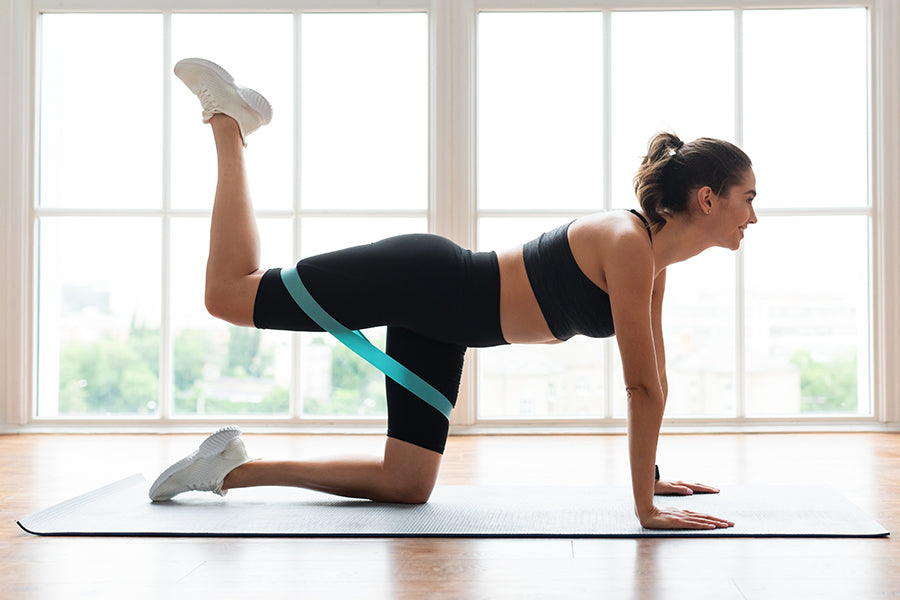In the world of fitness, resistance bands have gained significant popularity due to their versatility and convenience. They provide an effective way to build strength, enhance flexibility, and improve overall fitness without the need for bulky equipment or a gym membership. A resistance band workout can be performed virtually anywhere, making it an ideal solution for those who prefer to exercise at home. In this article, we will explore a comprehensive full-body resistance band workout that can help you achieve your fitness goals while enjoying the comfort of your home environment.
Understanding Resistance Bands

Resistance bands are elastic bands used for physical exercise. They come in various lengths, widths, and resistance levels, allowing users to customize their workouts according to their individual strength and conditioning levels. These bands are particularly advantageous because they create constant tension during exercises, leading to increased muscle engagement.
Using resistance bands not only helps in building strength but also improves coordination and flexibility. Unlike traditional weights, which rely on gravity, resistance bands challenge the muscles throughout the entire range of motion. This unique feature allows for a more dynamic workout experience that can yield impressive results.
The Different Types of Resistance Bands
Resistance bands come in several types, each serving a different purpose in achieving fitness goals. Recognizing these variations can help you choose the appropriate band for your workout routine.
The first type is the loop band, usually used for lower body exercises. Loop bands are circular and can easily fit around the legs. They are perfect for glute activation and leg strengthening exercises.
Next, we have the tube bands, which often come with handles attached. These bands are versatile and can be used for both upper and lower body workouts. The handles make them easy to grip, offering better control during curls, presses, and other movements.
Finally, there are therapy bands, which are flat strips of latex material. These bands are widely used in rehabilitation settings and are excellent for gentle stretching or low-impact exercises.
Each type of band provides varying levels of resistance, thus catering to different fitness levels. By selecting the right band, individuals can ensure they effectively challenge themselves while minimizing the risk of injury.
Benefits of Resistance Band Workouts
A resistance band workout offers numerous benefits that make them appealing to a wide range of fitness enthusiasts. One notable advantage is their portability, as they can easily be packed in a bag or suitcase. This makes them an ideal companion for travel or outdoor workouts.
Another significant benefit is joint safety. Since resistance bands offer variable resistance, they place less stress on the joints compared to some free weight exercises. This makes them suitable for individuals recovering from injuries or seniors looking to maintain strength without excessive strain.
Additionally, resistance bands promote functional strength by mimicking real-life movements. This kind of training enhances muscle coordination and stability, preparing your body for daily tasks and activities.
In summary, resistance bands are a fantastic tool for anyone wanting to increase their fitness level, regardless of their experience or background. By incorporating these bands into a structured routine, individuals can enjoy a comprehensive workout that targets multiple muscle groups.
Setting Up Your Home Gym for Resistance Band Workouts
Creating a dedicated space for your resistance band workout can significantly enhance your motivation and workout experience. A well-organized home gym doesn’t require much space or extravagant equipment; a few essential items can set the groundwork for an effective workout environment.
Choosing the Right Space
The location of your home gym plays a crucial role in how effectively you can maintain your workout routine. Look for a quiet area that has enough space for movement and access to natural light if possible. Having windows can uplift your mood, making your workout feel less like a chore.
Make sure to clear the area of any clutter to avoid distractions. Ideally, the space should allow for various exercises where you can stretch, perform cardio, and utilize your resistance bands without feeling cramped.
Essential Equipment
While resistance bands are the primary focus, a few additional pieces of equipment can enhance your workout experience. Having a yoga mat is beneficial for floor exercises and stretches, providing cushioning and grip.
If you wish to incorporate cardiovascular elements, consider adding a jump rope or light dumbbells. These items can complement your resistance band routines, offering variability and further enhancing your fitness regimen.
Lastly, don’t forget about hydration! Keeping a water bottle nearby ensures you stay hydrated throughout your sessions, especially when you’re working hard with your resistance bands.
Designing Your Workout Schedule
Establishing a consistent workout schedule is vital for achieving your fitness goals. Consider your personal commitments and identify specific days and times dedicated to your resistance band workout.
You might start with three to four sessions per week, focusing on different muscle groups or workout themes each day. For example, allocate one day for upper body exercises, another for lower body, and a third for core and flexibility work.
Keeping track of your workouts in a journal or using fitness apps can also help monitor your progress and motivate you to stay committed. Over time, you can adjust the frequency and intensity based on how your body responds to the workouts.
A Comprehensive Full Body Resistance Band Workout
Now that you understand the basics of resistance bands and how to set up your home gym, it’s time to dive into a full-body resistance band workout. This workout targets all major muscle groups, promoting balanced strength development and fitness.
Upper Body Exercises
The upper body is essential for functional movements and maintaining a strong posture. Incorporating resistance bands into your upper body workouts can significantly enhance strength, endurance, and toning.
One popular upper body exercise is the resistance band chest press. Anchor the band behind you at chest height, grab onto the ends, and press forward, engaging your chest and triceps. This movement mimics the action of a bench press but places less strain on your shoulders and wrists.
Another effective exercise is the seated row. Sit on the floor with your legs extended and wrap the band around your feet. Pull the band towards your torso while keeping your elbows close to your body. This works your back muscles and promotes good posture.
Don’t forget about shoulder exercises, such as lateral raises. Stand on the band with your feet shoulder-width apart and lift the ends of the band out to the side until they’re at shoulder height. This exercise effectively targets the deltoids and improves shoulder stability.
Lower Body Exercises
The lower body is often neglected in many workout routines, yet it’s crucial for overall strength and functional fitness. Resistance bands can add an extra dimension to lower body exercises, making them more challenging and effective.
To engage the glutes, try the banded squats. Place the band just above your knees, stand with feet shoulder-width apart, and squat down while pushing your knees outward against the band. This variation activates the glutes and inner thighs, contributing to better squat mechanics.
Lateral band walks are also excellent for targeting the hip abductors. With the band around your ankles, take small steps to the side while maintaining tension in the band. This simple movement strengthens the outer hips, improving stability and performance in other exercises.
Lastly, consider incorporating bridges with bands. Lie on your back with your knees bent and the band positioned over your hips. Lift your hips off the ground while pressing the band upward, activating your glutes and hamstrings. This movement is fantastic for improving core stability and functional strength.
Core Strengthening Exercises
A strong core acts as the foundation for nearly every movement you perform, making it essential for both athletic performance and daily activities. Resistance bands can significantly enhance your core workouts, providing added resistance and variety.
One effective core exercise is the banded Russian twist. Sit on the floor with your knees bent and hold the band with both hands, placing it under your feet. Rotate your torso to one side while pulling on the band, engaging your obliques. This rotational movement enhances core strength and stability.
Plank variations with resistance bands can also intensify your core workout. Attach the band to an anchor point and extend it under your arm while in a plank position. As you hold the plank, pull the band towards you, engaging your core and shoulders simultaneously.
Lastly, try the banded bicycle crunch. Lie on your back and place the band around your feet. As you perform the bicycle motion, pull on the band to increase the resistance, engaging your abs effectively. This combination of movement targets both the upper and lower abdominals.
Tips for Maximizing Your Resistance Band Workout
To get the most out of your resistance band workout, consider implementing some practical tips that can enhance your training experience.
Mind-Muscle Connection
Focus on establishing a strong mind-muscle connection during your workouts. Pay attention to the muscles you’re targeting and consciously engage them throughout each movement. This heightened awareness can lead to more effective workouts and better results over time.
Varying Resistance Levels
As you progress, it’s essential to vary the resistance levels of your bands. Using heavier bands or adjusting the length of the band can increase the challenge, stimulating muscle growth and preventing plateaus.
Incorporating different types of resistance bands into your routine can also keep workouts fresh and exciting. Switching between loop bands, tube bands, and therapy bands adds diversity and challenges your muscles in new ways.
Listening to Your Body
One of the most important aspects of any workout regimen is listening to your body. Pay attention to how you feel before, during, and after your resistance band workout. If you experience pain or discomfort, don’t hesitate to modify the movements or rest as needed.
Be patient with yourself and recognize that progress takes time. Celebrate small victories along the way, whether it’s completing an extra rep, mastering a new exercise, or simply enjoying your workouts more than ever.
Conclusion
A resistance band workout at home offers a flexible, effective, and enjoyable way to develop strength, flexibility, and overall fitness. By understanding the various types of resistance bands available and setting up a comfortable home gym, you can create a personalized workout routine that fits your lifestyle and goals.
This full-body resistance band workout we’ve explored provides a comprehensive approach to targeting all major muscle groups, allowing you to build strength and improve your physical abilities over time. Remember to listen to your body, vary your exercises, and focus on the mind-muscle connection as you progress through your fitness journey.
Embrace the opportunity to work out from home with resistance bands, and watch as your strength and confidence grow with each session. Whether you’re new to fitness or a seasoned enthusiast, resistance bands can empower you to achieve your goals and elevate your overall well-being.
Quick Home Workout: Boost Fitness in Just 15 Minutes a Day!


